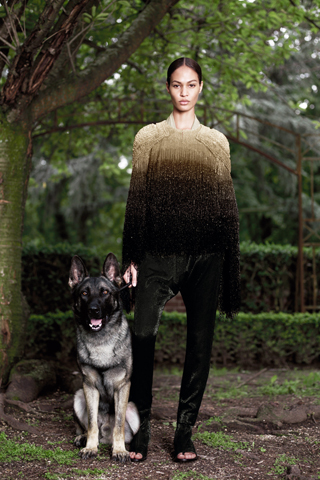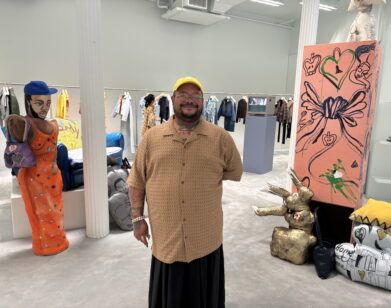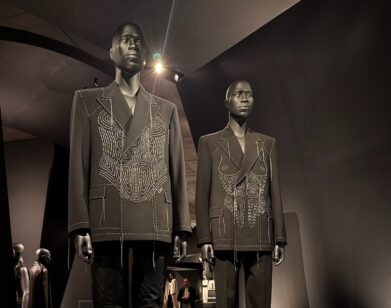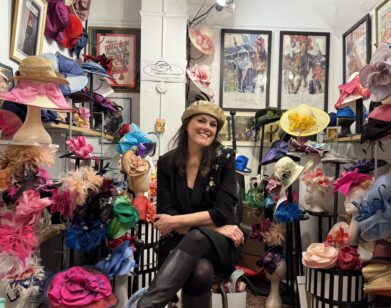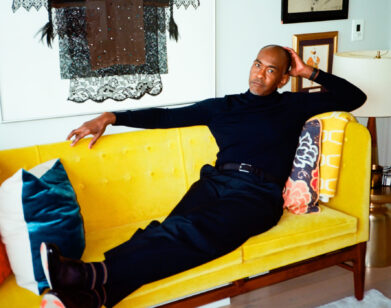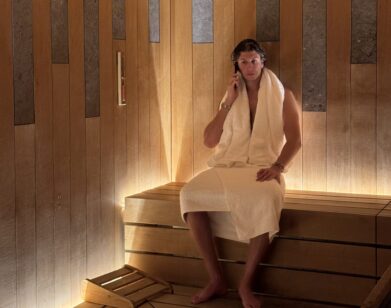Gypsies, Skylight, and Beyond Vintage from Givenchy, Armani Privé, and Chanel
Gypsy opulence and the pure lines of 1960s style went into the “collision of contradiction” in Riccardo Tisci’s labor-intensive couture for Givenchy, where he continues to stretch the limits of what can be done with materials. This season, it was leather. Tisci took nappa leather in skinny strips for full-length fringe gypsy shawl capes. The leather was twisted into 3-D passementerie to take the place of embroidery, and the strips were fused for a bodice and worked in a fine basket weave for a pair of high-thigh boots. Then he took mink, which he shaved or “plucked” into geometric textured lace for short kimono-sleeve coats, which were cut bolero length in the front or back and the exact opposite on the other side. All this opulence was in contrast with sedate ’60s beige cashmere wool for column-like dresses.
Givenchy’s mink stole, another nod to the ’60s, is twisted around for a plunging back, and it’s attached to the gown to form a coat-dress hybrid. And last but not least, Tisci found a new way with beaded fringe. His jacket, which is really like a tunic, mixes beads in all shapes and sizes, in gradated color fringe from beige to tobacco, worn over a beaded velvet jumpsuit with open-toed boots attached.
For Armani Privé, Giorgio Armani looked to the sky for his couture inspiration, and the gentle color palette—from rosy dawn to starry midnight blue—softened his outlook in a collection full of flowing silk velvet for pants and evening dresses, soft yoke paletots, slouchy cardigans, and gradated, pale skyline prints. Gentle, scoop-neck Spencers, crossover satin tops worn with crossover velvet skirts, a new bias top—almost like a poncho jacket—and little satin vests worn over glittering bustier dresses have a childlike, Pierrot look to them. By the end of the show, Armani’s models appeared like creatures of the night in jeweled veils and midnight-blue velvets covered with Swarovski crystal stardust.
Some of the best ideas begin as a reaction to what one doesn’t like. Karl Lagerfeld doesn’t like vintage—or retrospectives, for that matter. And so he invented what he calls “new vintage” for Chanel this season. From the looks of this day-wear-filled collection (and even the evening wear mimicked day wear this season) what he means is real couture, clothes for ladies who wear the suits and whose eternal wardrobes fly far above trends. The pièces de resistance in the middle of all this were the fake tweeds—painstakingly recreated in embroidery and appliqué—a wonderful trompe l’oeil that only Chanel couture could pull off. One coat redid tweed entirely in sequins.
Chanel looked ladylike, beginning with the boxy V-neck, four-pocket jacket and ample skirt worn with fingerless grey gloves that opened the show. A genteel mix of pink and white and gray held sway, tinged with silver shot into the tweeds, in stockings, and on the heels and toes of low black pumps. Jagged patchwork tweeds and lace, sleeveless dresses with silky wings, soft tattered satin bows, elaborate flower-scattered lace snoods, and one sequined jogging jumpsuit that looked almost spray-painted were more grande dame than debutante. And at the end of the show, a snowy white bride emerged dressed in a mixed-feather cape: an amazing piece only Chanel could produce.

